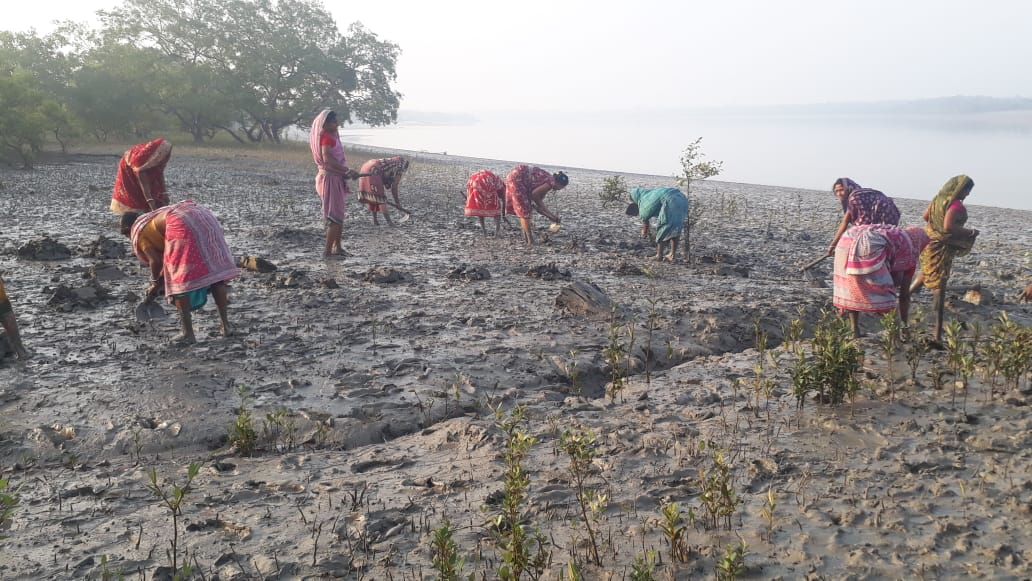How DRCSC empowers communities to thrive on the cyclone-prone coast of the Bay of Bengal
In 2018, the Climate Justice Resilience Fund awarded the Development Research Communication and Services Centre (DRCSC) a four-year, $700,000 grant to support its integrated approach to building climate resilience. Now neighboring farmers are starting to copy the adaptive measures.
Women working on a mangrove plantation. Photo credit: DRCSC
Along the Bay of Bengal coast, running across the India-Bangladesh border, resides a cluster of low-lying islands, famous for its unique mangrove forests. This area is known as the Sundarbans and is home to people who are vulnerable to dangerous and increasingly volatile climate activity – like cyclones and floods.
Cyclones are a frequent occurrence in the Bay of Bengal. Despite occupying just 0.6% of the global ocean area, more than 80% of cyclone-related deaths are from this region. In May 2021, Cyclone Yaas hit the Indian state of West Bengal, disrupting the life and livelihoods of many who call the Sundarbans home.
“Cyclone Yaas devastated the area,” shared Priya Sinha of the Development Research Communication & Service Centre (DRCSC). “Most of the crops ended up underwater and their roots were soaked for more than 40 hours.”
DRCSC works with the rural poor in the Sundarbans. For nearly 30 years, the organization has used scientific management of natural resources and community-based initiatives to improve the food and livelihood security of those living there. This includes teaching adaptable farming techniques, like developing a raised bed system that allows excess water to drain or growing crops in bags, a term known as sack cultivation.
“Our farming techniques made a big difference in the aftermath of Cyclone Yaas,” Sinha said. “70-80% of the farms we’ve worked with remained intact, while other farmers lost all their crops. Now, our beneficiaries are teaching other farmers about these methods. It’s creating a ripple effect throughout the community.”
DRCSC supports diverse farming practices, including livestock support. Photo credit: DRCSC
DRCSC sees their impact not only through opportunities to share these techniques with vulnerable communities, but also in their direct efforts to empower poor women and their families.
As an example, Sinha shared the story of Renu Halder, who lives in the Bhasapara village in West Bengal. Halder’s husband worked on homes in and around the village, but he could no longer do this strenuous work as he aged. In an effort to support themselves, their family tried cultivating vegetables. Yet, the climate conditions, including frequent flooding of brackish water, made this a difficult task.
“We strived to grow crops,” shared Halder in a case study for DRCSC. “However, the land was so saline that cultivating vegetables was tough.”
Halder worked with DRCSC and joined a women’s group that promotes economic and environmental sustainability practices called a Mutual Cooperation Group. There, she received training on ecological agriculture techniques. This included training on pest repellent methods, learning how to grow produce using sacks, and creating drainage systems.
This support has been life changing – and relieved a financial burden for Halder’s family.
Renu Halder now uses more resilient and sustainable farming practices that improve the well being of her and her family. Photo credit: DRCSC
“I am now able to grow, sell, distribute and consume the crops which I produce,” Halder shared. “I am not dependent on the market for vegetables, rice, fish, eggs, or poultry. Even the spices are grown in my garden.”
For DRCSC and Sinha, this type of impact is also at the heart of their work.
“Success shows up in many ways,” Sinha shared. “For the husband who had to leave his village to find work, he doesn’t have to do that now because his wife works in sustainable ways that support their family. He can work on his own land, and that is an achievement for us.”



